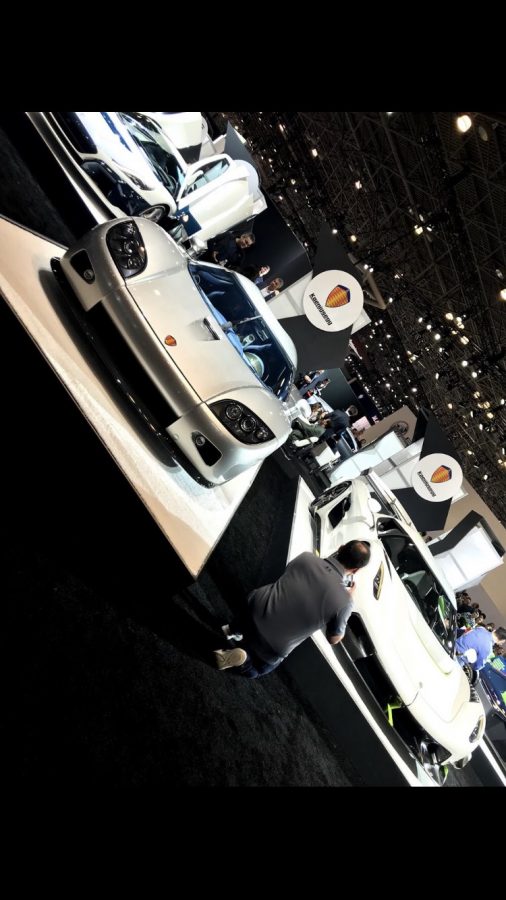Record Breakers
The Bugatti Chiron recently clocked in a top speed of 300 miles per hour, setting a new benchmark for high performance vehicles.
Koenigsegg rule the hypercars exhibit at the New York Auto Show.
I can remember the amazement that I felt watching the newest episode of my favorite car show Top Gear about a decade ago. Host James May suited up for a lap in the newly released Bugatti Veyron at Volkswagen’s top speed text track, the Ehra Lessien. The Veyron’s design immediately lived up to its reputation as the fastest production car in the world. Its huge hood was specially designed to supply all sixteen of its cylinders with 45,000 liters of air per minute. With its sport mode engaged, the Veyron deployed its rear spoiler and lowered itself so it appeared to be hugging the ground.
May approached the 9 kilometer straight off the Ehra Lessien, so vast in length that its other end was shrouded by clouds. The tranquil, cloudy day in the German countryside was shattered by the Bugatti as it reached 200, 300, and then finally a record breaking speed 417 kilometers per hour (259 miles per hour). May could not help but smile, knowing that he had set a record for the fastest speed achieved in a production vehicle.
Three hundred miles an hour, I thought to myself. James May’s record was something I thought would never be broken, but it goes to show just how much the automotive industry has advanced over the years.
I was seven at the time, and my bedroom walls were always coated with posters of supercars and my car collection expanded across my room. As I got older, the number of posters and toy cars I had in my room gradually shrunk, but my passion for automobiles always remained. Recently, I saw an Instagram clip from a new Top Gear episode of the new Bugatti Chiron tearing through the Ehra Lessien at a record setting 300 miles an hour. I was about to scroll past the video, but that number made me double take. Three hundred miles an hour, I thought to myself. James May’s record was something I thought would never be broken, but it goes to show just how much the automotive industry has advanced over the years.
The 300 miles per hour mark is an achievement long anticipated in the automotive world. In 1986, the Porsche 959 pushed the envelope on just how technologically advanced a supercar could be. Not only did it boast electric windows, magnesium wheels, and air pressure sensors, but it took the title for the fastest car in the world with a top speed of 197 miles an hour.
In response to Porsche dethroning their previously held record, Ferrari produced a masterclass in engineering with the F40 a year later. The F40 set a new speed record, reaching the coveted 200 mile an hour mark. Its twin turbo 2.9 liter V8 engine fueled the iconic red machine to speeds never reached before. “My father is really into cars, and he remembers just how amazed the automotive community was because of that accomplishment,” said Faheem Karim ‘20.
Just as Porsche strove to do years ago, many manufacturers have recently come close to reaching the illustrious 300 mile an hour mark. “I felt like every year there would be new cars that set new standards of excellence for the automotive industry,” said Ilan Grossman ‘23. The Bugatti Veyron that I remember watching as a kid was the first car to get within range of that standard. Then came attempts from Hennessy with the Venom GT, reaching the 270 mile an hour mark with a tremendous 1244 horsepower engine, as well as from Swedish engineers at Koenigsegg with the Agera reaching speeds of 277 mph.
On a sunny August morning, professional automotive racer Andy Wallace took a seat in the Bugatti Chiron, a machine built to break records. Months went into preparing the Chiron for the goal it was about to accomplish. Specially designed Michelin tires and aerodynamic body molding were some of the many modifications Bugatti engineers focused on during production.
The heavily tuned Veyron engine roared to life and pushed the Chiron past the technological Porsche – Ferrari rivalry of the 80s, the Veyron’s ex – milestone mark, and smashed Koenigsegg’s previously held record with a top speed of 304 miles per hour, setting a new standard for the automobiles of the future. If history has taught us anything, however, it’s that records are meant to be broken.
Rasheed Hossain is a Groups Section Reporter for the Bronx Science yearbook, ‘The Observatory,’ and a Sports Editor for the school newspaper, ‘The...











